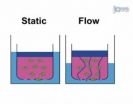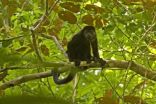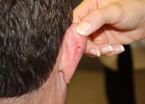(Press-News.org) GREENBELT, Md. -- Researchers analyzing meteorite fragments that fell on a frozen lake in Canada have developed an explanation for the origin of life's handedness – why living things only use molecules with specific orientations. The work also gave the strongest evidence to date that liquid water inside an asteroid leads to a strong preference of left-handed over right-handed forms of some common protein amino acids in meteorites. The result makes the search for extraterrestrial life more challenging.
"Our analysis of the amino acids in meteorite fragments from Tagish Lake gave us one possible explanation for why all known life uses only left-handed versions of amino acids to build proteins," said Dr. Daniel Glavin of NASA's Goddard Space Flight Center in Greenbelt, Md. Glavin is lead author of a paper on this research to be published in the journal Meteoritics and Planetary Science.
In January, 2000, a large meteoroid exploded in the atmosphere over northern British Columbia, Canada, and rained fragments across the frozen surface of Tagish Lake. Because many people witnessed the fireball, pieces were collected within days and kept preserved in their frozen state. This ensured that there was very little contamination from terrestrial life. "The Tagish Lake meteorite continues to reveal more secrets about the early Solar System the more we investigate it," said Dr. Christopher Herd of the University of Alberta, Edmonton, Canada, a co-author on the paper who provided samples of the Tagish Lake meteorite for the team to analyze. "This latest study gives us a glimpse into the role that water percolating through asteroids must have played in making the left-handed amino acids that are so characteristic of all life on Earth."
Proteins are the workhorse molecules of life, used in everything from structures like hair to enzymes, the catalysts that speed up or regulate chemical reactions. Just as the 26 letters of the alphabet are arranged in limitless combinations to make words, life uses 20 different amino acids in a huge variety of arrangements to build millions of different proteins. Amino acid molecules can be built in two ways that are mirror images of each other, like your hands. Although life based on right-handed amino acids would presumably work fine, they can't be mixed. "Synthetic proteins created using a mix of left- and right-handed amino acids just don't work," says Dr. Jason Dworkin of NASA Goddard, co-author of the study and head of the Goddard Astrobiology Analytical Laboratory, where the analysis was performed.
Since life can't function with a mix of left- and right-handed amino acids, researchers want to know how life – at least, life on Earth -- got set up with the left-handed ones. "The handedness observed in biological molecules – left-handed amino acids and right-handed sugars – is a property important for molecular recognition processes and is thought to be a prerequisite for life," said Dworkin. All ordinary methods of synthetically creating amino acids result in equal mixtures of left- and right-handed amino acids. Therefore, how the nearly exclusive production of one hand of such molecules arose from what were presumably equal mixtures of left and right molecules in a prebiotic world has been an area of intensive research.
The team ground up samples of the Tagish Lake meteorites, mixed them into a hot-water solution, then separated and identified the molecules in them using a liquid chromatograph mass spectrometer. "We discovered that the samples had about four times as many left-handed versions of aspartic acid as the opposite hand," says Glavin. Aspartic acid is an amino acid used in every enzyme in the human body. It is also used to make the sugar substitute Aspartame. "Interestingly, the same meteorite sample showed only a slight left-hand excess (no more than eight percent) for alanine, another amino acid used by life."
"At first, this made no sense, because if these amino acids came from contamination by terrestrial life, both amino acids should have large left-handed excesses, because both are common in biology," says Glavin. "However, a large left-hand excess in one and not the other tells us that they were not created by life but instead were made inside the Tagish Lake asteroid." The team confirmed that the amino acids were probably created in space using isotope analysis.
Isotopes are versions of an element with different masses; for example, carbon 13 is a heavier, and less common, variety of carbon. Since the chemistry of life prefers lighter isotopes, amino acids enriched in the heavier carbon 13 were likely created in space.
"We found that the aspartic acid and alanine in our Tagish Lake samples were highly enriched in carbon 13, indicating they were probably created by non-biological processes in the parent asteroid," said Dr. Jamie Elsila of NASA Goddard, a co-author on the paper who performed the isotopic analysis. This is the first time that carbon isotope measurements have been reported for these amino acids in Tagish Lake. The carbon 13 enrichment, combined with the large left-hand excess in aspartic acid but not in alanine, provides very strong evidence that some left-handed proteinogenic amino acids -- ones used by life to make proteins -- can be produced in excess in asteroids, according to the team.
Some have argued that left-handed amino acid excesses in meteorites were formed by exposure to polarized radiation in the solar nebula – the cloud of gas and dust from which asteroids, and eventually the Solar System, were formed. However, in this case, the left-hand aspartic acid excesses are so large that they cannot be explained by polarized radiation alone. The team believes that another process is required.
Additionally, the large left-hand excess in aspartic acid but not in alanine gave the team a critical clue as to how these amino acids could have been made inside the asteroid, and therefore how a large left-hand excess could arise before life originated on Earth.
"One thing that jumped out at me was that alanine and aspartic acid can crystallize differently when you have mixtures of both left-handed and right-handed molecules," said Dr. Aaron Burton, a NASA Postdoctoral Program Fellow at NASA Goddard and a co-author on the study. "This led us to find several studies where researchers have exploited the crystallization behavior of molecules like aspartic acid to get left-handed or right-handed excesses. Because alanine forms different kinds of crystals, these same processes would produce equal amounts of left- and right-handed alanine. We need to do some more experiments, but this explanation has the potential to explain what we see in the Tagish Lake meteorite and other meteorites."
The team believes a small initial left-hand excess could get amplified by crystallization and dissolution from a saturated solution with liquid water. Some amino acids, like aspartic acid, have a shape that lets them fit together in a pure crystal – one comprised of just left-handed or right-handed molecules. For these amino acids, a small initial left- or right-hand excess could become greatly amplified at the expense of the opposite-handed crystals, similar to the way a large snowball gathers more snow and gets bigger more rapidly when rolled downhill than a small one. Other amino acids, like alanine, have a shape that prefers to join together with their mirror image to make a crystal, so these crystals are comprised of equal numbers of left- and right-handed molecules. As these "hybrid" crystals grow, any small initial excess would tend to be washed out for these amino acids. A requirement for both of these processes is a way to convert left-handed to right-handed molecules, and vice-versa, while they are dissolved in the solution.
This process only amplifies a small excess that already exists. Perhaps a tiny initial left-hand excess was created by conditions in the solar nebula. For example, polarized ultraviolet light or other types of radiation from nearby stars might favor the creation of left-handed amino acids or the destruction of right-handed ones, according to the team. This initial left-hand excess could then get amplified in asteroids by processes like crystallization. Impacts from asteroids and meteorites could deliver this material to Earth, and left-handed amino acids might have been incorporated into emerging life due to their greater abundance, according to the team. Also, similar enrichments of left-handed amino acids by crystallization could have occurred on Earth in ancient sediments that had water flowing through them, such as the bottoms of rivers, lakes, or seas, according to the team.
The result complicates the search for extraterrestrial life – like microbial life hypothesized to dwell beneath the surface of Mars, for example. "Since it appears a non-biological process can create a left-hand excess in some kinds of amino acids, we can't use such an excess alone as proof of biological activity," says Glavin.
###The research was funded by the NASA Astrobiology Institute, the Goddard Center for Astrobiology, the NASA Cosmochemistry Program, and the Natural Sciences and Engineering Research Council of Canada.
For an image, refer to:
http://www.nasa.gov/topics/solarsystem/features/life-turned-left.html
NASA and university researchers find a clue to how life turned left
2012-07-26
ELSE PRESS RELEASES FROM THIS DATE:
Women with diabetes more likely to experience sexual dissatisfaction
2012-07-26
Women with diabetes are just as likely to be interested in, and engage in, sexual activity as non-diabetic women, but they are much more likely to report low overall sexual satisfaction, according to a UCSF study.
The researchers also found that diabetic women receiving insulin treatment were at higher risk for the specific complications of lubrication and orgasm.
"Diabetes is a recognized risk factor for erectile dysfunction in men, but there have been almost no data to indicate whether it also affects sexual function in women," said senior author Alison J. Huang, ...
How the fluid between cells affects tumors
2012-07-26
July 25, 2012
There are many factors that affect tumor invasion, the process where a tumor grows beyond the tissue where it first developed. While factors like genetics, tissue type and environmental exposure affect tumor metastasis and invasion, physical forces like fluid flow remain a poorly understood component of tumor invasion. A new video article in JoVE, the Journal of Visualized Experiments, describes a novel procedure that allows researchers to study and test the microenvironment of a growing tumor. The technique is valuable because it allows scientists to assay ...
Piglets in mazes provide insights into human cognitive development
2012-07-26
URBANA -- Events that take place early in life almost certainly have consequences for later cognitive development. Establishing the connections is difficult, however, because human infants cannot be used as laboratory subjects.
Rodney Johnson and his collaborators have developed an alternative model for studying infant brain development. "Assistant professor Ryan Dilger and I became interested in establishing the neonatal piglet as a model of human brain and cognitive development 3 or 4 years ago," he said.
The idea came to Johnson when a former student, who was working ...
Texas A&M biologists prove ZOLOFT packs potential to fight fungal meningitis
2012-07-26
New research conducted by biologists at Texas A&M University suggests that ZOLOFT®, one of the most widely prescribed antidepressants in the world, also packs a potential preventative bonus — potent mechanisms capable of inhibiting deadly fungal infections.
The findings are the result of a two-year investigation by Xiaorong Lin, assistant professor of biology, and Matthew S. Sachs, professor of biology, involving sertraline hydrocholoride (ZOLOFT) and its effects on Cryptococcus neoformans, the major causative agent of fungal meningitis — specifically, cryptococcal meningitis, ...
Increasing dopamine in brain's frontal cortex decreases impulsive tendency, UCSF-Gallo study finds
2012-07-26
Raising levels of the neurotransmitter dopamine in the frontal cortex of the brain significantly decreased impulsivity in healthy adults, in a study conducted by researchers at the Ernest Gallo Clinic and Research Center at the University of California, San Francisco.
"Impulsivity is a risk factor for addiction to many substances, and it has been suggested that people with lower dopamine levels in the frontal cortex tend to be more impulsive," said lead author Andrew Kayser, PhD, an investigator at Gallo and an assistant professor of neurology at UCSF. "We wanted to ...
Tropical arks reach tipping point
2012-07-26
Almost half of the tropical forest reserves in a new study are ineffective, according to results published in the journal Nature by William Laurance, research associate at the Smithsonian Tropical Research Institute now at James Cook University in Australia and more than 200 co-authors.
"Biodiversity is declining rapidly at reserves including Kahuzi Biega in the Democratic Republic of Congo, Xishuangbanna in southern China, and Northern Sierra Madre in the Philippines, among others," said Laurance. "Reserves that are doing relatively well include Bwindi Impenetrable N.P. ...
Researchers find new gene mutation associated with congenital myopathy
2012-07-26
Ann Arbor, Mich. — University of Michigan researchers have discovered a new cause of congenital myopathy: a mutation in a previously uncharacterized gene, according to research published this month in the American Journal of Human Genetics.
About 50% of congenital myopathy cases currently do not have a known genetic basis, presenting a clear barrier to understanding disease and developing therapy, says James Dowling, M.D., Ph.D., the paper's co-senior author and assistant professor of Pediatric Neurology at the University of Michigan's C.S. Mott Children's Hospital. Finding ...
Basal cell carcinoma risk can be chronic
2012-07-26
PROVIDENCE, R.I. [Brown University] — In the powerful sunlight of July, newly published results from a large study of people at high risk for basal cell carcinoma support the emerging view of the nation's most common cancer as a chronic ailment that often repeatedly afflicts older people but for which the seeds may be planted in youth. The research also found a new association with eczema.
"Basal cell carcinoma is a chronic disease once people have had multiple instances of it, because they are always at risk of getting more," said Dr. Martin Weinstock, professor of dermatology ...
High blood sugar, obesity increase risk for surgical site infection
2012-07-26
Two recent studies in the July issues of the Journal of Bone and Joint Surgery (JBJS) looked at surgical site infections and hyperglycemia, the technical term for high blood glucose, or high blood sugar. According to the first study "Relationship of Hyperglycemia and Surgical-Site Infection in Orthopaedic Surgery," high blood sugar is a concern during the post-traumatic and post-operative period and it may help to preoperatively identify a population of patients with musculoskeletal injuries who are at significant risk for infectious complications.
Nearly, one-third ...
Sum of the parts? How our brains see men as people and women as body parts
2012-07-26
When casting our eyes upon an object, our brains either perceive it in its entirety or as a collection of its parts. Consider, for instance, photo mosaics consisting of hundreds of tiny pictures that when arranged a certain way form a larger overall image: In fact, it takes two separate mental functions to see the mosaic from both perspectives.
A new study suggests that these two distinct cognitive processes also are in play with our basic physical perceptions of men and women -- and, importantly, provides clues as to why women are often the targets of sexual objectification.
The ...



